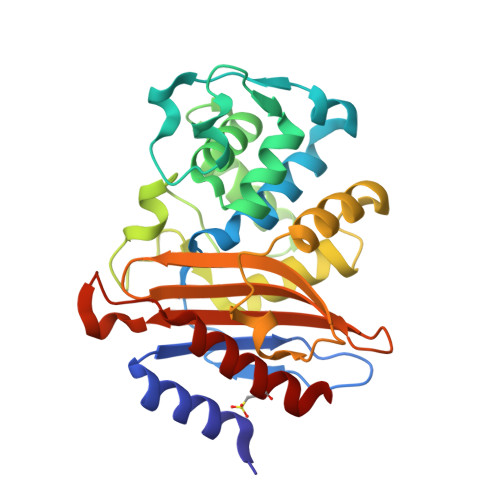The G132S Mutation Enhances the Resistance of Mycobacterium tuberculosis beta-Lactamase against Sulbactam.
van Alen, I., Chikunova, A., Safeer, A.A., Ahmad, M.U.D., Perrakis, A., Ubbink, M.(2021) Biochemistry 60: 2236-2245
- PubMed: 34250791
- DOI: https://doi.org/10.1021/acs.biochem.1c00168
- Primary Citation of Related Structures:
7A5T, 7A5W, 7A71, 7A72 - PubMed Abstract:
The current rise of antibiotic resistant forms of Mycobacterium tuberculosis is a global health threat that calls for new antibiotics. The β-lactamase BlaC of this pathogen prevents the use of β-lactam antibiotics, except in combination with a β-lactamase inhibitor. To understand if exposure to such inhibitors can easily result in resistance, a BlaC evolution experiment was performed, studying the evolutionary adaptability against the inhibitor sulbactam. Several amino acid substitutions in BlaC were shown to confer reduced sensitivity to sulbactam. The G132S mutation causes a reduction in the rate of nitrocefin and ampicillin hydrolysis and simultaneously reduces the sensitivity for sulbactam inhibition. Introduction of the side chain moiety of Ser132 causes the 104-105 peptide bond to assume the cis conformation and the side chain of Ser104 to be rotated toward the sulbactam adduct with which it forms a hydrogen bond not present in the wild-type enzyme. The gatekeeper residue Ile105 also moves. These changes in the entrance of the active site can explain the decreased affinity of G132S BlaC for both substrates and sulbactam. Our results show that BlaC can easily acquire a reduced sensitivity for sulbactam, with a single-amino acid mutation, which could hinder the use of combination therapies.
- Leiden Institute of Chemistry, Leiden University, Einsteinweg 55, 2333CC Leiden, The Netherlands.
Organizational Affiliation:


















